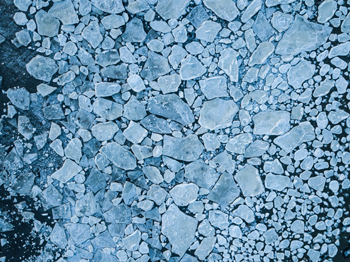
Studying scattered waves
Waves are all around us. There are sound waves, water waves, electromagnetic waves, and vibration waves to name just a few. Despite the differences between them, all waves have the same underlying mathematical framework. Sine functions describe perfect waves of given frequencies and amplitudes, and more complex waveforms can be built by adding up sine waves of different shapes. Conversely, complicated waveforms can be split into simpler components using the more advanced mathematics of Fourier analysis. These tools allow us to understand waves and harness their power.

Waves arising in nature can behave in complex ways.
But while the mathematics of waves has been around for a long time, it is far from complete. When a wave meets an object in its path, it scatters off it in different directions. When many waves meet multiple objects, the scattering pattern soon becomes extremely complex — and so does the mathematical problem of calculating the pattern. See this article for an illustration of this complexity.
The existing mathematics of waves is not sufficient to solve many current problems involving waves scattered by multiple objects. This is why experts on multiple wave scattering from all around the world are currently gathered at the Isaac Newton Institute for Mathematical Sciences (INI) in Cambridge for a six month long research programme to push the field ahead.
"Research on multiple wave scattering has been centred around the different application areas," says Luke Bennetts who co-organises the programme. "It's an aim of our programme to bring together researchers from the different application areas to share [mathematical] techniques and methods — because those developed in a particular application area are very likely to benefit all the other application areas." (You can read about Bennetts's own field of work on the dynamics of the Southern Ocean here.)
Ice and invisibility
An example of the powerful applications of multiple wave scattering, as well as the challenges involved, are metamaterials — materials that are artificially designed to have certain properties. "[It is possible to design] a material so that waves will follow a particular path through the material," says Valerie Pinfield who co-organises the INI programme. An exciting example comes from materials designed for invisibility cloaks. "Using optical wave scattering [it's possible] to make the waves travel in such a way that you can't tell there was an object there, so you have cloaked it," says Pinfield. "This really does exist — you can make a material which does that." (You can listen to a podcast with Pinfield here.)

An aerial drone view of ice floes on ocean surface in the Norways arctic sea. Although the floes form an irregular pattern it can be useful to assume the pattern is regular.
Metamaterials are usually arranged in tiny repeating patterns designed to interact with waves in a particular way. That's in theory at least — the perfect periodicity of the materials can't be reproduced exactly in reality, so the real materials are likely to come with flaws. What we need to know is whether those flaws are likely to disrupt the properties the material was designed to have. "Geometric mathematical idealisations are not always reproducible in the fabrication process," says co-organiser Malte Peter. "So there's an essential, pressing question about how stable effects are with respect to random perturbations."
A similar gap between theory and practice arises when it comes to natural materials and structures. An example is ocean waves travelling through fields of ice floes in the Arctic and Antarctic oceans. One way of making the mathematical analysis easier is to imagine the ice fields to exhibit repeating patterns even though in reality they are not that regular. "Sometimes these approximations [by periodic patterns] lead to very good results and have proven to be very powerful, but sometimes they give entirely wrong answers," says Peter. "Therefore it's indispensable to understand the limits of the theories and methods. So we're very interested in bringing together communities and finding out what the limits of [the methods] are. These issues really arise in all application fields."
X-rays and mayonnaise
The problems posed by invisibility cloaks and ice floes involve developing the mathematics that tells you what you can expect to observe as a result of physical processes, such as waves interacting with objects. But the field of multiple wave scattering also poses so-called inverse problems, which work the other way around: given what you have observed, use mathematics to work out the physical processes that caused the observations.

A CAT scan of the inside of a head.
Such techniques can also be used to understand what is going on inside other materials, for example to figure out how long food emulsions, such as mayonnaise, are likely to keep. "We can transmit an [ultrasound] wave through the [mayonnaise] and it will bounce off all the different particles," explains Pinfield, who specialises in using ultrasonics for the characterisation of materials. "The overall result of that is a perceived loss of energy in the wave as it travels through the materials. By looking at that loss of energy as a function of frequency, that's a spectroscopy technique, we can then work out the concentration of particles, the density of particles, the size of particles, and so on. This allows us to detect something about the properties of the material." (For another example of the use of spectroscopy, see this article.)
Paving the way for future technologies
These examples give you a taste of the applications and mathematical problems involved, but there are many others too and the mathematics involved is deep. When mathematical expressions that provide exact solutions are elusive, as is often the case, mathematicians turn to numerical methods, which employ computers to provide approximate solutions. "These numerical methods in themselves are in development all of the time and are very closely linked to the analytical methodology as well," says Pinfield.
The INI programme on multiple wave scattering aims to explore analytical and numerical methods as they apply to a variety of applications, bringing together, not just senior researchers in the field, but also early career researchers and representatives from industry.
The results may one day affect us all. "Through discussion, collaboration, and communication we can learn from each other to pick up the commonalities between methods [developed in different areas] and identify the key differences," says Pinfield. "It's about identifying the best strategy to make the most rapid progress towards solving some of these big problems, which will in themselves result in new technologies that can make a difference to our day-to-day life in the future."
About this article
This article is based on the video interview below, produced by Dan Aspel from the INI, and on our podcast interview with Valerie Pinfield. Click here to see all our content relating to the INI programme Mathematical theory and applications of multiple wave scattering.
Luke Bennetts is an Australian Research Council Future Fellow and an Associate Professor in the School of Mathematical Sciences, University of Adelaide.
Malte Peter is Professor of Applied Analysis at the University of Augsburg, Germany.
Valerie Pinfield is Professor of Engineering at Loughborough University, UK.
Marianne Freiberger is Editor of Plus.
This article was produced as part of our collaboration with the Isaac Newton Institute for Mathematical Sciences (INI) – you can find all the content from the collaboration here.
The INI is an international research centre and our neighbour here on the University of Cambridge's maths campus. It attracts leading mathematical scientists from all over the world, and is open to all. Visit www.newton.ac.uk to find out more.
